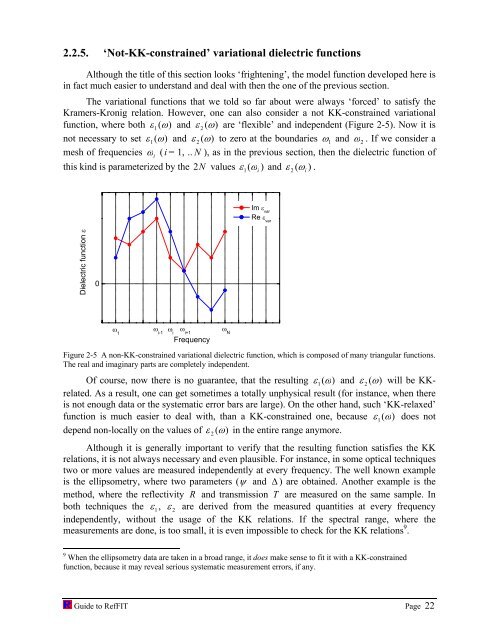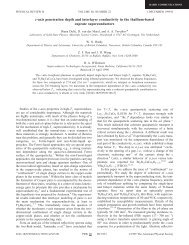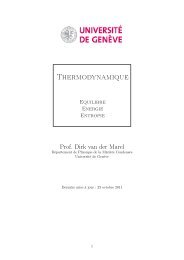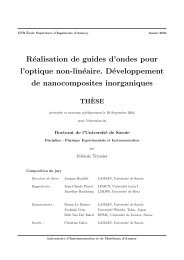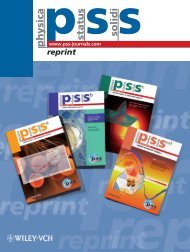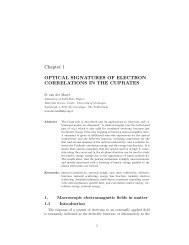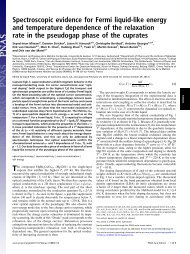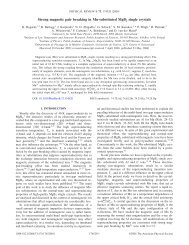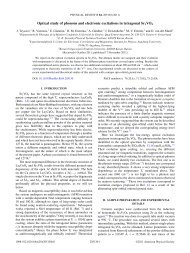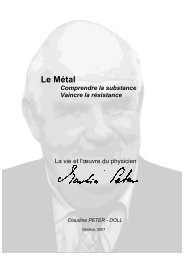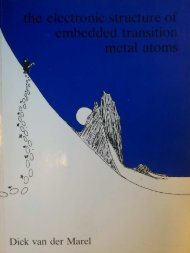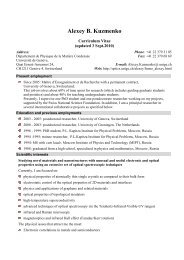software to fit optical spectra - Quantum Materials Group
software to fit optical spectra - Quantum Materials Group
software to fit optical spectra - Quantum Materials Group
You also want an ePaper? Increase the reach of your titles
YUMPU automatically turns print PDFs into web optimized ePapers that Google loves.
2.2.5. ‘Not-KK-constrained’ variational dielectric functions<br />
Although the title of this section looks ‘frightening’, the model function developed here is<br />
in fact much easier <strong>to</strong> understand and deal with then the one of the previous section.<br />
The variational functions that we <strong>to</strong>ld so far about were always ‘forced’ <strong>to</strong> satisfy the<br />
Kramers-Kronig relation. However, one can also consider a not KK-constrained variational<br />
function, where both ε 1( ω)<br />
and ε 2 ( ω)<br />
are ‘flexible’ and independent (Figure 2-5). Now it is<br />
not necessary <strong>to</strong> set ε 1( ω)<br />
and ε 2 ( ω)<br />
<strong>to</strong> zero at the boundaries ω 1 and ω 2 . If we consider a<br />
mesh of frequencies ω i (i = 1, .. N ), as in the previous section, then the dielectric function of<br />
this kind is parameterized by the 2 N values ε ( ω ) and ε ( ω ) .<br />
Dielectric function ε<br />
0<br />
ω 1<br />
ω i-1<br />
ω i<br />
ω i+1<br />
Frequency<br />
ω N<br />
1 i<br />
Im ε var<br />
Re ε var<br />
Figure 2-5 A non-KK-constrained variational dielectric function, which is composed of many triangular functions.<br />
The real and imaginary parts are completely independent.<br />
Of course, now there is no guarantee, that the resulting ε 1( ω)<br />
and ε 2 ( ω)<br />
will be KKrelated.<br />
As a result, one can get sometimes a <strong>to</strong>tally unphysical result (for instance, when there<br />
is not enough data or the systematic error bars are large). On the other hand, such ‘KK-relaxed’<br />
function is much easier <strong>to</strong> deal with, than a KK-constrained one, because ε 1( ω)<br />
does not<br />
depend non-locally on the values of ε ( ) in the entire range anymore.<br />
2 ω<br />
Although it is generally important <strong>to</strong> verify that the resulting function satisfies the KK<br />
relations, it is not always necessary and even plausible. For instance, in some <strong>optical</strong> techniques<br />
two or more values are measured independently at every frequency. The well known example<br />
is the ellipsometry, where two parameters (ψ and ∆ ) are obtained. Another example is the<br />
method, where the reflectivity R and transmission T are measured on the same sample. In<br />
both techniques the ε 1,<br />
ε 2 are derived from the measured quantities at every frequency<br />
independently, without the usage of the KK relations. If the <strong>spectra</strong>l range, where the<br />
measurements are done, is <strong>to</strong>o small, it is even impossible <strong>to</strong> check for the KK relations 9 .<br />
9 When the ellipsometry data are taken in a broad range, it does make sense <strong>to</strong> <strong>fit</strong> it with a KK-constrained<br />
function, because it may reveal serious systematic measurement errors, if any.<br />
Guide <strong>to</strong> RefFIT Page 22<br />
2 i


